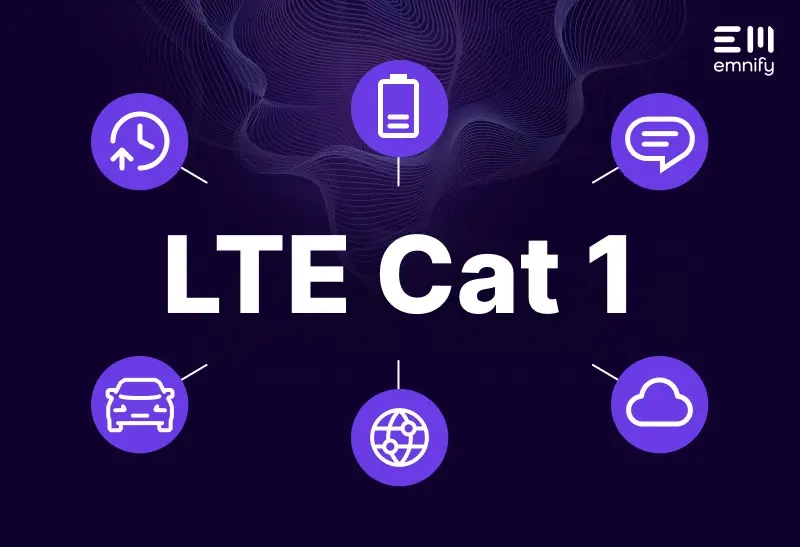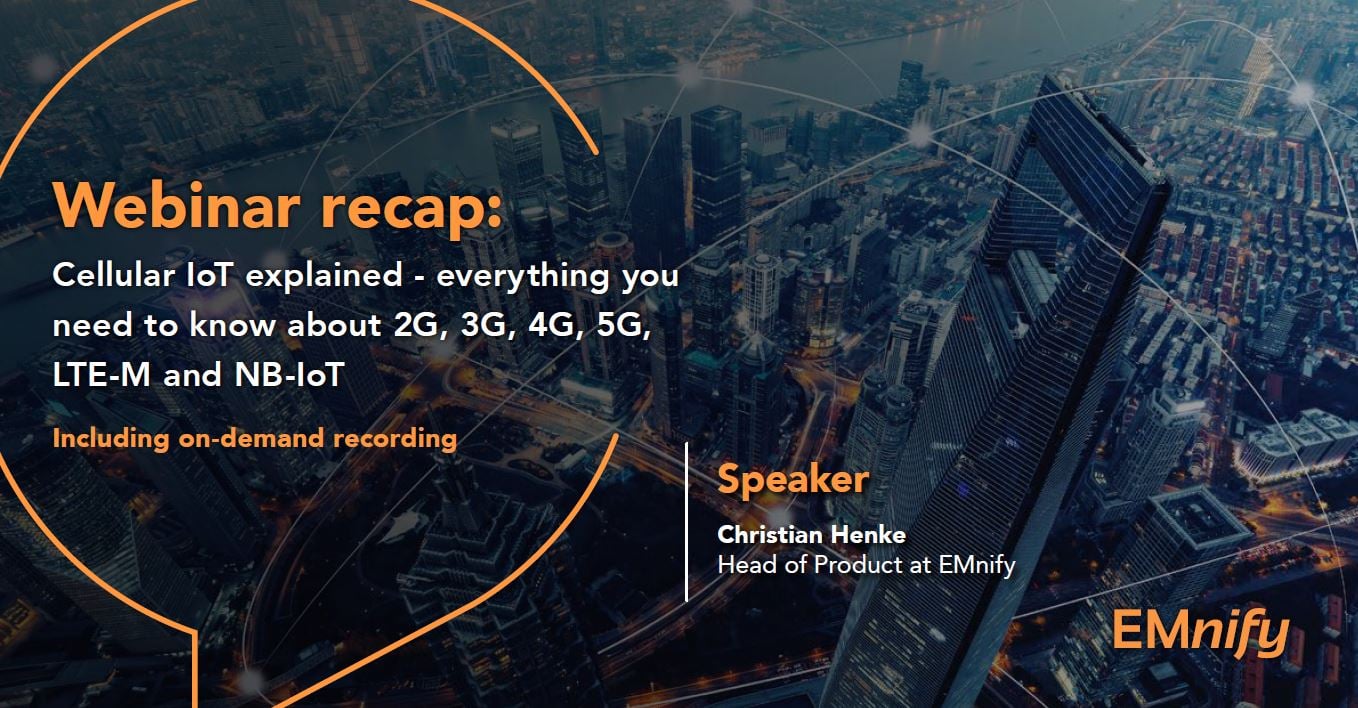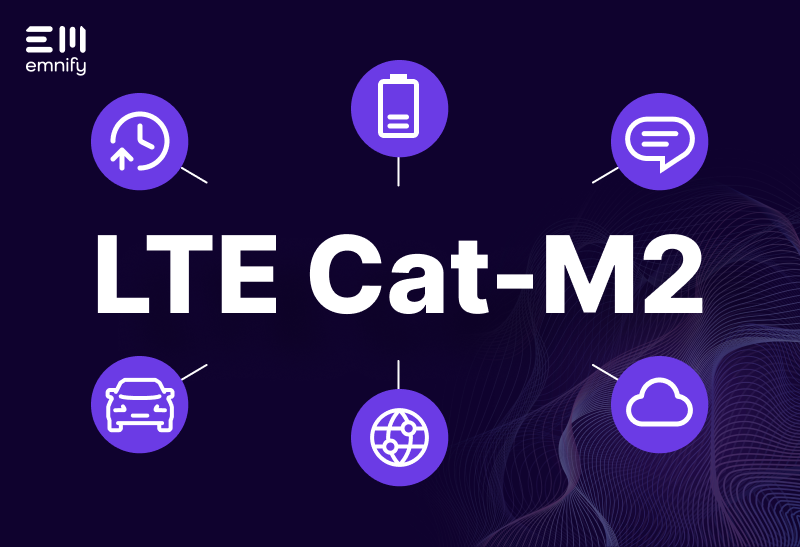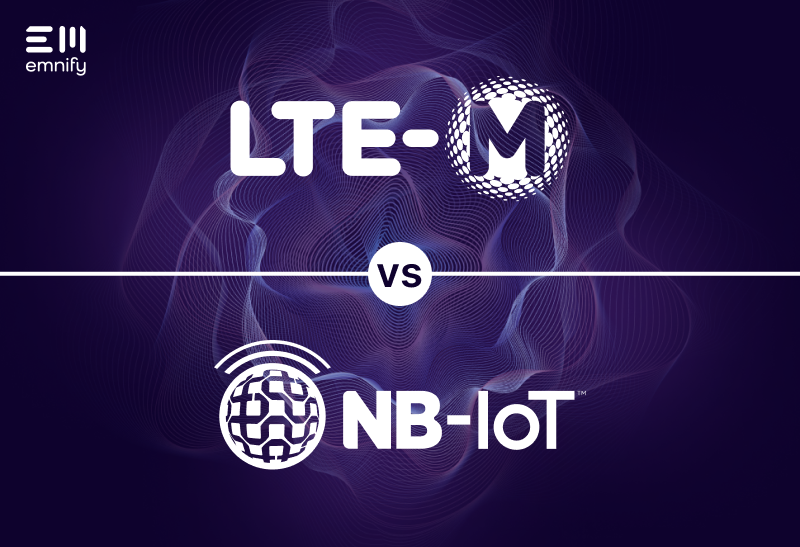

Quick definition: LTE Cat-1 is a variation of 4G LTE technology. Short for Long Term Evolution Category 1, LTE Cat-1 was standardized in 2008 as the first branch of LTE designed specifically for the Internet of Things. Cellular IoT has evolved significantly and LTE Cat-1 is still a popular choice for IoT manufacturers. The infrastructure is well established and the technology still has valuable use cases, such as healthcare IoT, point of sale systems, and dashcams.
LTE has more than 20 distinct User Equipment (UE) categories that define specific uplink and downlink capabilities. The lower the category number, the slower its data speeds are. This means LTE Cat-1 consumes less power and is less complex than higher LTE UE categories, making it better suited for battery-powered devices.
Since it was built for the Internet of Things, Cat-1 also boasts longer idle times and sleep modes than higher tiers of LTE technology.
LTE vs LTE Cat-1 vs. LTE Cat-M1
Since they have similar names and the same purpose (adapting LTE technology to IoT), it would be easy to confuse LTE, LTE Cat-1 and LTE Cat-M1. LTE Cat-M1 is the first version of LTE-M, or Long Term Evolution Machine Type Communication for low power devices. LTE-M is an increasingly valuable connectivity option for IoT applications, but LTE Cat-1 has a couple of situational advantages over this newer technology.
|
LTE (Cat 3-12) |
LTE Cat-1 |
LTE Cat-M1 |
|
|
Worldwide Coverage |
Excellent |
Excellent - same as LTE |
Poor / Medium - mostly western industrial countries |
|
Bandwidth |
20 MHz |
20 MHz |
1.4 MHz |
|
Downlink rate |
100-600 Mbps |
10 Mbps |
1 Mbps |
|
Uplink rate |
50-150 Mbps |
5 Mbps |
1 Mbps |
|
Power consumption |
High |
Medium |
Very low |
|
Cost |
High |
Medium |
Low |
Global roaming
The greatest weakness of Low Power Wide Area Networks (LPWANs) like LTE-M and NB-IoT is that they currently are not deployed worldwide and NB-IoT especially has very few roaming options, which makes them less useful for global deployments than more established cellular technologies.
LTE Cat-1 simply has wider coverage because LTE CAT-1 is present everywhere that 4G/LTE is available and roaming is not limited. This means that devices can easily switch to a different network in case there is no coverage in the specific location, providing better connection reliability.
Bandwidth
In general, IoT devices use significantly less data than cell phones. There are billions more of them, but they use a fraction of the available bandwidth that is physically available. LTE has been designed to provide fast data transmission for smartphones and LTE is therefore leveraging large frequency bands of 20 Mhz. LTE-Cat 1 uses the same frequency bands.
LTE-M1 uses less than one-tenth of the bandwidth of LTE and LTE-Cat 1. LTE-M uses 1.4 MHz as bandwidth which allows operators to provide more LTE-M channels - this increasing the capacity of the number of devices that can connect in a specific area. If you are concerned about having too many devices in a cell than LTE-M and NB-IoT is a better option.
Data Throughput
While 1Gbps is theoretically possible with LTE advanced - utilizing technologies like Carirer and 4x4 Mimo - typical industrial routers for broadband IoT use cases in the CAT6 or 12 category - providing a maximum data rate of 600Mbps in downlink and 150Mbps in upload.
For typical IoT use cases these high data rates are not necessary - and actually counter-productive due to higher cost and power consumption.
LTE CAT-1 enables most IoT use case by providing 10Mbps in downlink and 5Mbps in uplink which is suitable for video streaming or aggregated data transmission of multiple devices over cellular gateways. LTE-M provides less data throughput with 300kbps - 1Mbit/s in uplink and downlink. It enables all singular device use case - even for image or video content - but may not be sufficient for aggregated high data use cases.
Power Consumption
Standard LTE technology is power hungry - the cellular module is not only draining the battery while transmitting data, but also while waiting for data to be sent to the device in idle mode. Given that most IoT use cases are uplink centric, same features have been developed to reduce the power consumption. One of them is Power Saving-Mode (PSM) which allows the modem to go to sleep when not transmitting data without needing to search for a network again when waking up. PSM is available in LTE CAT-1 and LTE-M modules which greatly reduces the power demand.
Nevertheless LTE CAT-1 utilizes more power than LTE-M as the radio logic is more complex - with the 20Mhz bandwidth and higher possible data throughput the data processing is not power optimized.
Cost
LTE modules are cost intensive as they have been optimized to provide the best user experience with high data speeds. With its lower complexity LTE CAT-1 modules provide an alternative as the costs are about 30% cheaper compared to LTE CAT-6 modules.
LTE-M and NB-IoT are the cheapest module with a price of around 10€/$. LTE-M / NB-IoT modules are less complex and have been optimized for massive machine type communication.
Find the right solution for your application
As LTE-M coverage grows, it will likely become one of the more dominant connectivity solutions for IoT. Still, LTE Cat-1 will continue to be a smart choice for your applications for its ability to deliver similar benefits with greater data throughput.
The best network type for your IoT application depends on your unique circumstances, including:
- The countries, regions, and locations you plan to deploy in
- The scale of your deployments
- The data needs of your devices and customers
- The incremental impact from module cost to the total cost of your device
At emnify, we empower IoT manufacturers to build devices that connect to more than 540 networks in over 180 countries, facilitating truly global coverage. In over 100 countries we provide LTE and LTE CAT-1 connectivity. Want to see how it works?
Learn more about emnify's managed IoT Connectivity platform.
Get in touch with our IoT experts
Discover how emnify can help you grow your business and talk to one of our IoT consultants today!

Nhu has over six years of experience working with networking technologies and IoT connectivity solutions. She’s an avid tech learner with a customer-focused mindset.


